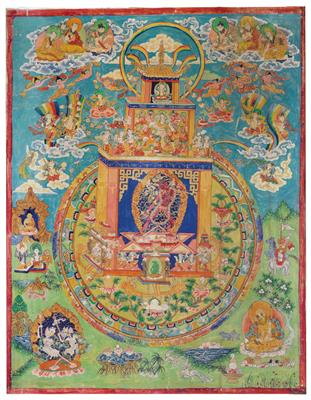A thangka ‘Vajrayogini and the Pure Land of Khechara’, Tibet, 19th/20th cent., Sakya Tradition,
A thangka ‘Vajrayogini and the Pure Land of Khechara’, Tibet, 19th/20th cent., Sakya Tradition,

pigment with a water-soluble binding agent on textile, gold paint, image size 57 x 44 cm, in mat, framed, behind glass, (Hr)
We are grateful to Mr Uwe Niebuhr, BA, MA for his assistance with the cataloguing of this work.
This thangka depicting Vajrayogini in the Pure Land of Khechara (Tib.: rdo rje rnal 'byor ma mkha' spyod) is based on the teachings of the Indian scholar, Mahasiddha Naropa. Also known as Naropa’s Khechari or Naro Khachod, this cycle of the five founding scholars (Tib.: gong ma lnga) was incorporated in the 11th century in the Sakya tradition of Tibetan Buddhism. It was only in the 17th century that that Naropa’s Khechari also gained popularity within the Gelupga Tradition, being widely disseminated throughout Tibet later independently of the Sakya Tradition, because it is extremely easy to practice and comprehend. As a depiction of Buddhahood in female form, Vajrayogini is classified as wisdom or mother tantra of the highest degree - as Anuttarayoga Tantra, with its origin in the Cakrasamvara Cycle of the Tantras.
Red Vajrayogini, depicted with an angry face, two arms and legs, stands on a double tetrahedron on the first storey of a three-storey heavenly palace. In her right hand, she holds a cleaver (Skt.: kartri, Tib.: gri gug) and with her left, she drinks from a blood-filled skull cup (Skt.: kapala, Tib.: thod pa), and rests a tantric rod (Skt.: khatvanga) on her shoulder. The gates of the palace, which rests on a large double vajra within a circular mandala, are guarded by protective deities with animal heads. Dakinis dance around the central figure. Cakrasamvara is seated on the second storey surrounded by Sakya scholars in the Vajrayogini lineage. The third storey with its rainbows is the residence of the Buddha Vajradharma, whose hands cross his chest and hold a vajra and a bell. Mahasiddhas and Lamas sit on two clouds and are attended by dakinis, flying up amongst them, and heavenly musicians.
To the left-hand side of the thangka, two kneeling patron figures can be seen. In the lower half of the image, are the dancing skeletons of Śri Citipati, which serve as protective deities in Naropa’s Khechari. The orange-coloured god of wealth, Jambhala, is depicted to the lower right corner of the image surrounded by many sacrificial offerings.
Esperta: Regina Herbst
 Regina Herbst
Regina Herbst
+43-1-515 60-356
regina.herbst@dorotheum.at
08.04.2019 - 14:00
- Prezzo realizzato: **
-
EUR 2.000,-
- Prezzo di partenza:
-
EUR 1.600,-
A thangka ‘Vajrayogini and the Pure Land of Khechara’, Tibet, 19th/20th cent., Sakya Tradition,
pigment with a water-soluble binding agent on textile, gold paint, image size 57 x 44 cm, in mat, framed, behind glass, (Hr)
We are grateful to Mr Uwe Niebuhr, BA, MA for his assistance with the cataloguing of this work.
This thangka depicting Vajrayogini in the Pure Land of Khechara (Tib.: rdo rje rnal 'byor ma mkha' spyod) is based on the teachings of the Indian scholar, Mahasiddha Naropa. Also known as Naropa’s Khechari or Naro Khachod, this cycle of the five founding scholars (Tib.: gong ma lnga) was incorporated in the 11th century in the Sakya tradition of Tibetan Buddhism. It was only in the 17th century that that Naropa’s Khechari also gained popularity within the Gelupga Tradition, being widely disseminated throughout Tibet later independently of the Sakya Tradition, because it is extremely easy to practice and comprehend. As a depiction of Buddhahood in female form, Vajrayogini is classified as wisdom or mother tantra of the highest degree - as Anuttarayoga Tantra, with its origin in the Cakrasamvara Cycle of the Tantras.
Red Vajrayogini, depicted with an angry face, two arms and legs, stands on a double tetrahedron on the first storey of a three-storey heavenly palace. In her right hand, she holds a cleaver (Skt.: kartri, Tib.: gri gug) and with her left, she drinks from a blood-filled skull cup (Skt.: kapala, Tib.: thod pa), and rests a tantric rod (Skt.: khatvanga) on her shoulder. The gates of the palace, which rests on a large double vajra within a circular mandala, are guarded by protective deities with animal heads. Dakinis dance around the central figure. Cakrasamvara is seated on the second storey surrounded by Sakya scholars in the Vajrayogini lineage. The third storey with its rainbows is the residence of the Buddha Vajradharma, whose hands cross his chest and hold a vajra and a bell. Mahasiddhas and Lamas sit on two clouds and are attended by dakinis, flying up amongst them, and heavenly musicians.
To the left-hand side of the thangka, two kneeling patron figures can be seen. In the lower half of the image, are the dancing skeletons of Śri Citipati, which serve as protective deities in Naropa’s Khechari. The orange-coloured god of wealth, Jambhala, is depicted to the lower right corner of the image surrounded by many sacrificial offerings.
Esperta: Regina Herbst
 Regina Herbst
Regina Herbst
+43-1-515 60-356
regina.herbst@dorotheum.at
|
Hotline dell'acquirente
lun-ven: 10.00 - 17.00
kundendienst@dorotheum.at +43 1 515 60 200 |
| Asta: | Antiquariato |
| Tipo d'asta: | Asta in sala |
| Data: | 08.04.2019 - 14:00 |
| Luogo dell'asta: | Wien | Palais Dorotheum |
| Esposizione: | 02.04. - 08.04.2019 |
** Prezzo d'acquisto comprensivo di tassa di vendita e IVA
Non è più possibile effettuare un ordine di acquisto su Internet. L'asta è in preparazione o è già stata eseguita.
Lotti da altre aste
- Künstler um 1900
- Brosche aus Silber mit Blattdekor und Lapislazulibesatz, Karl Karst, Pforzheim, um 1900/15
- Wilhelm Veit, Vasenpaar 'Bathilde', Entwurf: 1918, Ausführung: Zeh, Scherzer & Co., Kunstabteilung, Rehau, um 1918-30
- Holzrelief mit einem Putto, mit Szepter und einem Vogel, um 1930
- Bronzefigur eines antikisierenden Kämpfers
